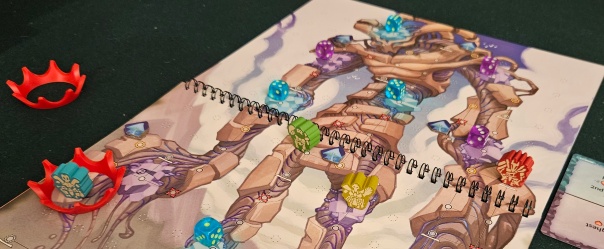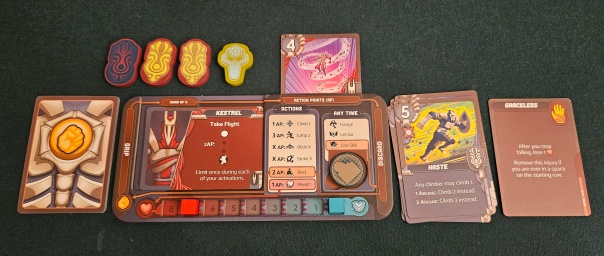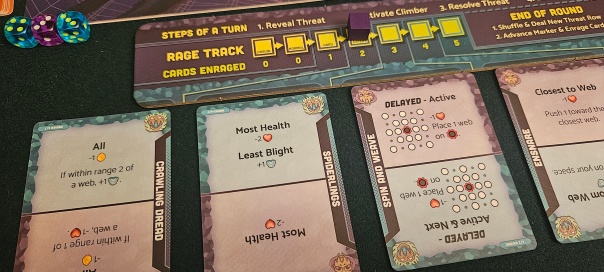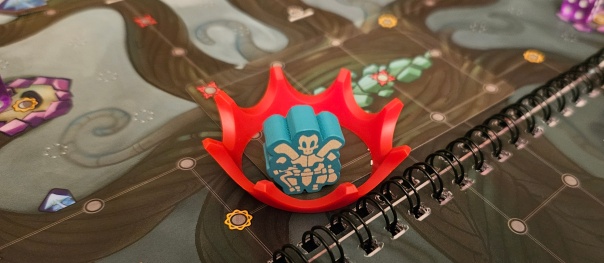Shadow of the Proboscis
Justin Kemppainen’s Leviathan Wilds wears its influences on its sleeve. One influence in particular: Shadow of the Colossus, the 2005 PlayStation 2 title that influenced a generation of up-and-coming designers. Like that game, Leviathan Wilds is about scaling behemothic creatures in order to punch them in their color-coded weak spots.
But Leviathan Wilds is a kinder giant-puncher. Gone are the melancholic grays, swapped out for a fuller palette and a conservationist ethic. These leviathans have been corrupted by nasty crystals, you see. Cured of the brobdingnagian gout, they will return to their gentle ways. Time to climb.
And climb you will. The act of climbing is handled superbly, a vertical challenge that saps your character’s stamina with every passing moment. Certain handholds are especially perilous, either inflicting damage or sharply decreasing your “grip,” the game’s byword for your deck and the measure of how much energy you have remaining. When your grip runs out, your character falls, tumbling back to the ground or, if you’ve lined up the angles, settling atop a platform where you can catch your breath and continue your journey upward.
In that sense, it’s very much like Shadow of the Colossus. The mere act of traversal is perilous in a way that few other board games have been. As much as the creature you’re scaling is a presence, it’s the tyrant gravity that’s always dragging at your heels.
The comparisons are so close, in fact, that I admit to some trepidation heading into Leviathan Wilds. Ask somebody who played Shadow of the Colossus as a bright-eyed kid in ’05 what the game meant to them and you’ll probably hear a lot more about their emotional response than about any actual colossi. It’s one thing to scale a series of big-ass monsters and jab them in the forehead. It’s another entirely to wonder if bringing them down was perhaps a net negative for the world.
To be sure, at times the storytelling in Leviathan Wilds stumbles. Each of the game’s seventeen creatures are introduced by a few sentences from one of the game’s climbers. Without exception, these are grating. One character bellyaches that he isn’t allowed to plunder the loot trapped atop a monster’s back; another slugs a creature in its eyeball when it looks too closely at him. Where Kemppainen stretches for a light tone, perhaps even a comedic air, he pokes his own a finger into the eyeball of his creations’ majesty. These leviathans should be objects of awe, not contempt.
Thank goodness, then, that such moments are so mercifully ignorable. The rest of the time, Leviathan Wilds is something special indeed.
It begins with your climber. As each scenario opens, you make precisely two decisions, first selecting a character and then determining their class. These are straightforward enough that they don’t strictly require forethought. You could, for instance, declare that you want to play as the little orange guy and that “breaker” sounds like a cool occupation. Mix their decks together and voila, there you are.
But there’s room to tinker, however minor. Characters provide either one or two cards and an ability. My favorite is Kestrel, who can perform a tremendous vertical leap once per turn, perfect for bypassing nasty handholds. Or maybe it’s Savvy, for her ability to mark a safe climbing route for other players, or even, thanks to one of her cards, letting somebody clamber through empty space via a temporary shortcut. Who am I kidding — it’s Cheer, with his endless supply of magic mushrooms. Every leviathan is populated by a few of the things ready to be harvested and used, but Cheer transforms them into a renewable supply of perks.
At the same time, the classes introduce the bulk of your cards — eight! — plus new ways to interact with the leviathan or your crewmates. Some of these are less complicated than others, like the breaker’s proficiency at smashing crystals or the freeclimber’s rapid but precarious movement. A few, though, offer new concepts entirely. The gadgeteer gets a special token that empowers their moves, but can only be used once per rest. The magus similarly boosts their power through arcane tokens, trickles of power that recharge over time. The silliest of the gang is the gambler, whose actions are either incredible feats of athleticism or slapstick sad-trombone noises, all depending on the flip of a coin. As someone who prefers to meticulously map out each step of my ascent, I am exactly the wrong person to play as the gambler.
But pretty much every other combo works, which of course is much the point. Everybody brings something useful to the team. In one session, I was the minstrel version of Hazard, stapled to the side of an infested hive and singing tunes to encourage my buds. In another, I was both Mystic and mender, keeping everybody’s grip and health topped off. This is the game’s purest departure from Shadow of the Colossus: much like actual climbing, it’s meant to be experienced as a group. At least with a partner.
As much as your climbers develop their own personalities, they’re rightly dwarfed by the leviathans. There are seventeen in all. Far more than being fresh illustrations, each comes with its own deck of cards and perhaps a setup chart. Not that these decks are especially thick. Like the characters themselves, whose decks range from nine to ten cards deep, each leviathan distinguishes itself through a combination of factors: the arrangement of the body you’ll be scaling, five cards that dictate its changing behavior, and maybe a special rule or two with complementing tokens spread across the map.
It’s an impressive system, producing a wide array of challenges with only a few components. Early leviathans have a refreshing honesty to them: they shake around a bit to loosen your grip, riddle you with “blight” — basically a ceiling on your hit points — or maybe slap an appendage at you. These latter assaults add angry red warning rings on the board, a fine approximation of the whole “an orange glowing zone means run away” thing from countless video games. Every card is also double-sided; as you spend extra rounds clambering across a leviathan’s body, it flips more of these to their scarier side. There’s no hard-coded time limit. Instead, each leviathan grows more aggressive, prompting you to hurry to clear away those crystals before you succumb to its attacks.
As the difficulty ramps up, so does the complexity. This is where Kemppainen flexes his creative muscles. In the game’s first few stages, I was worried that it would grow tedious. Before long, however, new elements are introduced and just as often abandoned. Past the second or third level, each leviathan does its own thing. There’s an arboreal leviathan that’s only vulnerable when its cyclopean eye is open, a hive frantic with swarming protectors, a creature that keeps its weak points in its gullet, leviathans with inbuilt elevators to manipulate, leviathans that teleport around the map, leviathans that bend gravity and therefore redirect your falls. Turning the page to see which monstrosity you’ll be delousing tonight is a joy.
In the process of tackling these creatures, Leviathan Wilds once again sidles into the presence of its inspirations. Despite the game’s departures from Shadow of the Colossus — its brighter colors, your well-intentioned objectives, even those groan-worthy snippets of monologue — there’s an undeniable majesty to these beings. Your climbers are roughnecks, leathery lads and lasses here to do a job. But you, the player, are given the space and distance to admire the artistry that went into each creature.
In the end, Leviathan Wilds is a pleasant surprise. Where it could have been too simple, it rises to the occasion. Where it could have been too complex, it keeps the systems underpinning its climbers and leviathans tidy. It’s replete with both startlements and wonders. All too often, an oncoming attack will threaten to swat you from a monster’s hide; in such moments, everyone scrambles to work through the problem. Leviathan Wilds provides the tools, letting players act out of turn to scamper out of danger or swoop to one another’s aid. The result is a game that always feels alive, always feels clever.
Even, like its monsters, one that brushes its fingers with the majestic.
(If what I’m doing at Space-Biff! is valuable to you in some way, please consider dropping by my Patreon campaign or Ko-fi.)
A complimentary copy was provided.
Posted on May 23, 2024, in Board Game and tagged Board Games, Leviathan Wilds, Moon Crab Games. Bookmark the permalink. 8 Comments.





This game looks great, I’m glad to hear that there is so much variety between the monsters. Now if only I can track down a copy…
I love this game!
Me too! We’re like twins!
Shadow Of The Colossus is one of those defining memories of my youthful days, and has somehow repeatedly spread its influence beyond the artificial borders of “just playing a video game.”
My son and I are slowly proceeding through Hollow Knight, and it’s neat to see how it is impressing itself on him, in a similar manner.
Really enjoy reading what you do here.
Thanks for the kind words! That’s very cool that you’re witnessing that process in your son.
All of the Shadow of the Collossus comparisons (from you and other reviewers) are a huge turn down for me. I found that video game both tedious and obtuse in all the worst ways
Here’s the good news: there are just as many contrasts as comparisons!
Pingback: Space-Cast! #38. Leviathan Wakes | SPACE-BIFF!